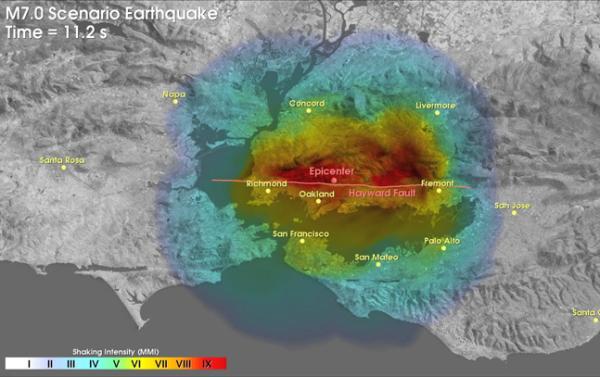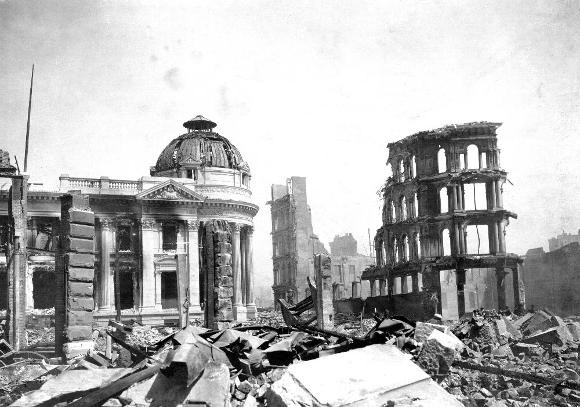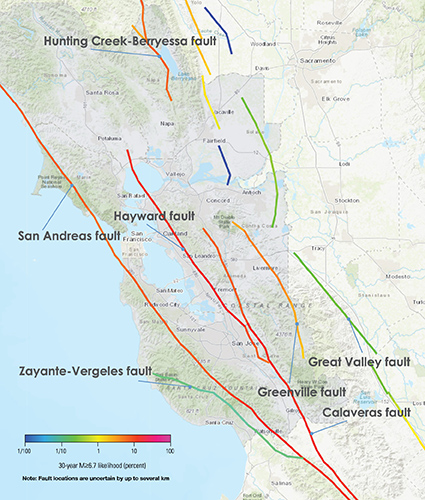What is the risk of a Bay Area Earthquake?
Understanding Earthquake Risk in San Francisco Bay Area
No crystal ball can accurately give us a San Francisco earthquake prediction. Earthquake scientists estimate that there is a 72% probability of a magnitude 6.7 or greater earthquake in the Bay Area in the near future.
Earthquake hazard is spread throughout the San Francisco Bay Area. The three faults in the Bay Area most likely to have a damaging earthquake are the Hayward Fault, the Calaveras Fault and the San Andreas Fault. The East Bay has a higher earthquake risk than the San Francisco Peninsula.
The 2014 South Napa magnitude 6.0 earthquake along the San Andreas fault killed one person, injured at least 208 people, and caused severe damage to 150 buildings and moderate damage to more than 1,000 buildings. In Solano County, it injured at least 49 people, caused severe damage to 10 buildings and caused moderate damage to more than 30 buildings.
See Your Local Earthquake Risk
San Francisco earthquake prediction
There is a 3 out of 4 chance of a damaging earthquake in the Bay Area in the next 30 years. USGS names the prime Earth movers as the San Andreas Fault, the Calaveras Fault, and the Hayward Fault. Seven million Bay Area residents need to be prepared for a major San Francisco earthquake and weeks of aftershocks.
Damages from a Hayward Fault rupture alone could shake one million homes with 77,000 to 152,000 households displaced.
Effects & damage of a major earthquake in the San Francisco Bay Area
It’s not just the Earth’s shaking that could produce billions in damages and lead to tens of thousands of Bay Area residents becoming homeless. It’s also that when San Francisco earthquakes occur, they cause liquefaction. Liquefaction can turn loosely packed, water-saturated soil to liquid and undermines home support structures. San Francisco and neighboring cities pose a high risk for liquefaction and landslides.
In April 2019, California Department of Conservation updated their liquefaction hazard map for the San Francisco Bay Area.
According to the map, the following neighborhoods are in danger from liquefaction: Marina District, Financial District, South of Market, South Beach, the East Cut/Salesforce Tower, Treasure Island, Ocean Beach, India Basin, Hunters Point, and Candlestick Point.
Outside of San Francisco, Alameda, San Leandro and Hayward rest within a liquefaction zone. West Oakland, West Berkeley and Emeryville also face risks.
One large liquefaction zone extends in the South Bay Peninsula from SFO down through Santa Clara and San Jose.
The Great 1906 San Francisco Earthquake
On April 18, 1906, a magnitude 7.9 (Mw) earthquake occurred in the San Francisco Bay Area. The Great 1906 San Francisco earthquake is one of California’s most famous and largest earthquakes.
It was the result of a rupture on the San Andreas fault that caused strong shaking felt as far north as Eureka and as far south as Salinas. It caused more than 3,000 deaths, approximately 225,000 injuries and $400 million in property damage.
Damage occurred well beyond San Francisco, such as into nearby Santa Cruz, San Benito and Monterey counties, where buildings collapsed, bridges were damaged, and river courses were altered.
The earthquake- and fire-wrecked Hibernia Bank Building in San Francisco, following the 1906 earthquake.
Photo credit: U.S. Geological Survey.
San Francisco Bay Area earthquake risk map with fault lines
San Francisco is very vulnerable to earthquakes. Its three notable faults, covered below, are right-lateral strike-slip faults. This is a type of shearing force where the right block moves toward the fault and the left block moves away.
Millions of Bay Area residents live near active fault zones. Find out your home’s risk and geological hazards by visiting CEA’s risk map and faults by county.
Notable faults in the San Francisco Bay area
While the City by the Bay holds much beauty, it sits above the most dangerous earthquake faults in the world. It’s not just the San Andreas fault that poses earthquake risk, but the Hayward fault and Calaveras fault can also cause major shaking, Earth rupture and landslides.
The San Andreas Fault
The San Andreas fault is one of the largest and most studied faults in the world. The fault runs more than 800 miles from the Salton Sea to Cape Mendocino and is 30 million years old. It divides the state with San Diego, Los Angeles and Big Sur on the Pacific Plate.
San Francisco, Sacramento and the Sierra Nevada are on the North American Plate. The two plates crisscross with many active and passive earthquake faults.
The communities of Daly City, Point Reyes Station and Bodega Bay lie squarely on the San Andreas. Scientist project the San Andreas Fault line could cause a devastating earthquake in California by 2030. The San Andreas fault caused the biggest earthquakes in California with an approximate magnitude 7.9 in 1857 (Southern California) and 1906 (San Francisco).
The Hayward Fault
History shows that five large earthquakes on the Hayward fault have occurred on average every 150 years—last being in 1868. The Hayward fault is due for another large earthquake very soon. The Hayward fault runs through the East Bay hills from Richmond to San Jose.
Nearly 3 million people currently live along the fault. According to U.S. Geological Survey (USGS), the Hayward fault is a “tectonic time bomb,” set to go off anytime now.

Hayward Fault Earthquake Scenario
This scenario shows the ground shaking for a magnitude 7.0 earthquake on the Hayward fault with the epicenter in Oakland, California. In this computer simulation constructed through a collaborative effort between the United States Geological Survey and the Southern California Earthquake Center, the slip or offset across the fault has the earthquake rupture start in Oakland. These scenarios are larger than the magnitude 6.8 Hayward 1868 earthquake, but are about as likely to occur because there has not been a large earthquake on the northern portion of the Hayward fault for about 300 years.
Calaveras Fault
The Calaveras fault is a major offshoot of the San Andreas fault in Northern California.
UC Berkeley reports that there is potential for larger earthquakes in the San Francisco Bay Area due to the direct connection between the Hayward and Calaveras faults.
Cities resting on the fault include Alamo, Danville, San Ramon, Dublin, Pleasanton, Sunol, Milpitas, San Jose, Gilroy, and Hollister.
How to mitigate earthquake damage
The shaking from a major San Francisco earthquake can move almost everything inside your home.
Prepare for the next earthquake by evaluating the safety of your home. Make or purchase your earthquake safety kit and gather essential supplies. Keep your family safe and prevent the injury of your loved ones by getting ready today. Don’t forget financial protection against earthquake damage with budget-friendly CEA earthquake insurance.
Know What to do During an Earthquake
An earthquake is a sudden, rapid shaking of the earth caused by the shifting of rock beneath the Earth’s surface. Earthquakes strike without warning, at any time of year, day or night.
Prepare now for your family’s safety and recovery from a devastating San Francisco earthquake. Create an earthquake safety plan. Practice Drop, Cover, and Hold On.
Learn about earthquake survival tips to keep your family prepared before the next big one hits.
Understand Geologic & Structural Risks to Your House
Whether it is the Hayward, Calaveras or San Andreas faults, San Francisco earthquake activity could cause great devastation for the Bay Area communities.
Understand the potential geologic threats to your home in case of a major earthquake by learning your San Francisco earthquake risk.
The violent shaking from earthquakes can rupture the earth, trigger landslides and turn the surface of the earth to liquid. Your home may be vulnerable to serious structural damage, particularly if it was built before 1980.
Purchase Affordable Coverage
Don’t be caught unprotected when the big one hits. Discover CEA affordable and flexible home earthquake policies that:
- Offer choices of coverage and deductibles.
- Protect the investment in your home and valuables.
- Provide homeowner premium discounts if you retrofit your home or mobilehome.
- Give you peace of mind when, not if, a major San Francisco earthquake strikes.
Typical home insurance policies and tenant insurance policies don’t include earthquake coverage. In California, the homeowner or renter needs a separate earthquake policy to cover damages from an earthquake. Choose your policy today with an estimate.
Is earthquake insurance worth it in San Francisco?
Scientists confirm that a San Francisco earthquake risk is looming. Can you afford to ride out the next major earthquake without the protection of earthquake insurance in the Bay Area?
- Earthquakes can cause extensive damage to the foundation, siding, and roof of homes. Older houses built before 1980 on a raised foundation are especially vulnerable if they have not been seismically retrofitted.
- Without residential earthquake insurance, you will be responsible for all repair and/or rebuilding costs.
- Government disaster assistance, if available, may only come in the form of a small grant or capped loan, which may cover only a portion of your repair costs and may need to be repaid.
- Without Loss of Use earthquake coverage—which includes covering your additional expenses of living elsewhere due to earthquake damage to your home—you’d still be paying your mortgage plus temporary housing rent during the time repairs are underway.
CEA’s affordable earthquake insurance policies let you select the coverage that fits your budget and needs. Discover the peace of mind with the smart financial decision to buy earthquake insurance.
How much is earthquake insurance in San Francisco?
San Francisco earthquake insurance premiums depend on the amount of coverage you choose, the location of your home, the home’s structure, and the amount of deductible you select.
Without earthquake insurance, you will have to pay from savings to repair and replace earthquake damage to your home and valuables, and cover needed temporary housing.
Get started today with an estimate.
Get an earthquake insurance estimate!
San Francisco is earthquake country with three active faults that could affect the safety and damage the property of millions of people.
Without CEA’s affordable earthquake residential insurance, you will be responsible for the cost to repair your home and replace your belongings after a major San Francisco earthquake.
No need to wait until your home policy renewal. Select from 5%-25% deductibles. Find out if earthquake insurance in San Francisco is right for you with an estimate now.
Get your earthquake insurance estimate
Sources Consulted:
- UCERF3: A New Earthquake Forecast for California’s Complex Fault System
- USGS South Napa Earthquake
- USGS San Andreas Fault
- San Jose Mercury News: A Look Back at the Napa Earthquake
- USGS: Back to the Future on the San Andreas Fault
- Geology.com: The San Andreas Fault
- San Francisco Chronicle: How Much Could an Earthquake Damage San Francisco
- USGS Hayward Fault
- USGS: Hayward Fault Scenario
- California Department of Conservation: California Earthquake Hazards Zone Application
- SFCurbed: Earthquake map reveals liquefaction risks in Bay Area neighborhoods



